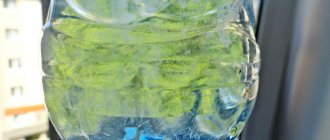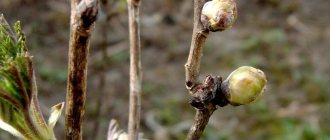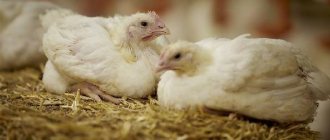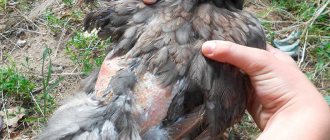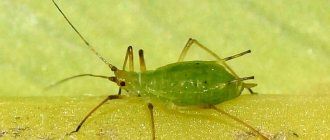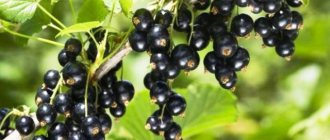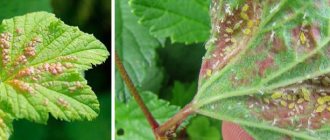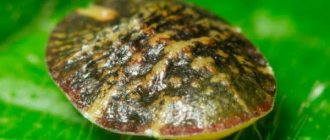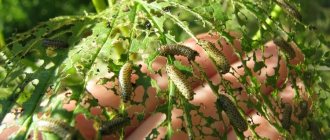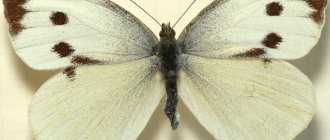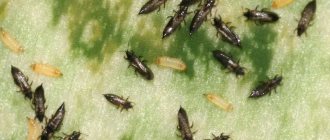One of the most common pests of currants is glass beetle. This insect causes significant damage to the bush.
Dear readers! For you, we have created communities on social networks in which useful articles and interesting ideas are published several times a day! Subscribe and receive useful content in a convenient format!
The problem is that it is very difficult to notice an infestation by this pest. And this makes the fight much more difficult.
In today's article we will tell you what glass is, why exactly it is harmful and how to deal with it.
What does the pest look like, signs of appearance on plants
First, let's figure out what the pest itself looks like.
The adult insect resembles a wasp with its black and yellow coloration. It has a more monolithic body. The wasp has a pronounced waist, while the glass beetle does not.
,
The wings of the insect have a clearly noticeable orange-brown tint. In addition, the glass is rather black with yellow stripes. He also has a long black mustache.
The caterpillar is small (about 2 cm), yellowish-gray in color and has a red-brown head. It is very difficult to detect, since it lives in the core of the currant branch.
ON A NOTE. After itself, the caterpillar leaves a channel along the entire length of the shoot.
It is very, very difficult to determine invasion in the early stages. The fact is that outwardly a diseased bush is no different from healthy ones.
Only over time do the infected branches begin to show signs of the presence of glassworm. Namely: withering of foliage, drying of branches, stunting of growth, decreased yield.
What harm does it cause and what plants does it affect?
In addition to currant bushes, the pest is also not averse to eating gooseberries and raspberries.
Infection usually begins in May-June. The adult lays eggs on the shoots of bushes, trying to place them in small cracks on the branches.
After about a couple of weeks, caterpillars emerge from the eggs. They bite into branches and get inside. There they feed on the tissues and sap of the plant.
During growth, the caterpillars move down to the base of the branches. This leads to drying and death of the shoot.
If you have strong currant bushes, they will be able to survive the pest’s impact. But the yield of berries will be significantly reduced.
It is noted that glass can reduce the harvest by half.
It causes the greatest harm to summer residents in Central Russia.
Characteristics of an insect
The glasswort Synanthedon tipuliformis CI belongs to the butterfly family. The insect loves black currants, but sometimes attacks red currants or gooseberries.
Description of appearance
Externally, the pest resembles a small wasp. The wings are narrow with orange stripes along the edges and black streaks. The wingspan is 25-28 cm. The body is oblong, up to 1 cm long, covered with dark gray scales. On the abdomen of females you can see 3 light stripes, and on the male - 4. The insect feeds on plant sap or pollen. This article will tell you about large-fruited tomato varieties for greenhouses.
Life cycle
At the end of May - beginning of June, the butterfly lays 50-60 eggs, each of which is 70 mm long and oblong in shape. For this process, she makes cracks in the bark of a tree-like shoot, certainly next to the young buds.
The greatest danger comes from insect larvae - white or beige caterpillars 2-2.5 cm long with a black head. 10 days after their appearance, they begin to cause harm, eating young shoots from the inside. Caterpillars penetrate deep into the stem, feed, and develop there. Thus, they descend lower and lower to the base of the plant, eating the core.
Before wintering, the length of the passage made by the caterpillar is 15-20 cm. After another year, this size increases to half a meter, and the adult branch dries out completely.
With the arrival of spring, the caterpillar crawls out. From the outside of the branch it pupates and gives birth to the next generation. A new butterfly appears in June, when the air temperature rises above +15°C. The activity of the insect lasts 40-42 days, and the mass period is 10-18 days, ending by the time the fruits ripen.
Find out about the description of the Shalunya cherry variety at this link.
The life cycle of glass is 2 years.
Folk measures to combat glassware on currants
First of all, let's discuss traditional methods of fighting insects.
Pruning and destroying diseased shoots
This is a simple but effective method. Prune dead branches to prevent the spread of larvae.
Jam traps
This is not exactly a control method, but a way to detect pests and determine when to begin combating them.
Place baits with fermented currant jam along the perimeter of the currant plantings. If you find glass particles in them, start processing.
Garlic infusion
Press 1-2 heads of garlic and fill the mixture with water. Let it brew. Then strain and treat the plants after flowering.
Sand and kerosene
Pour sand into a basin and soak it with kerosene. Make several of these preparations and place them between the currant bushes. The smell of kerosene will scare away the glass from the bush.
Aromatic infusion
Glasswort cannot stand the smell of pine needles, rotten onion skins, wormwood, shag and tansy. Make an infusion based on one of these products and treat the bushes before flowering and immediately after it.
Ammonia solution
Ammonia, which is contained in ammonia, perfectly repels glassware from your currants. Carry out processing starting in spring. Not only will you drive away the pest, but you will also fertilize the plant with nitrogen.
Preventive methods
Of course, prevention is the best treatment in pest control. After all, it is plants with weakened immunity that become victims of infectious diseases and harmful insects.
- Buy planting material only in trusted, specialized stores.
- Weeds should not be allowed to grow near the bushes.
- Regularly loosen and dig up the soil around the perimeter of the circle around the trunk.
- Constantly inspect the currant bush for the presence of gray butterflies on the leaves.
- Every 2-3 weeks, especially during the flowering period, cut off dried shoots.
- Collect dry branches and leaves under the bushes and throw them into the fire.
- If more than 40% of the shoots are affected by glassware, the bush must be uprooted and destroyed.
Frequency of treatments
In early spring, before the buds open, it is necessary to prune dry, frozen, black shoots. Perform pruning at the root so that there is no stump left. It is necessary to remove shoots lying on the surface of the ground. However, it is important not to cause mechanical damage to healthy branches.
At the end of the season, closer to winter, sanitary pruning is carried out. Thin out the bush, depriving it of underdeveloped and dead shoots. The sections are disinfected with garden varnish or pastes.
Preventative treatment with insecticides is carried out after warm weather sets in. The biological product “Antonem-F” is a good choice. Treatment should be carried out during the appearance of foliage and before the formation of ovaries. If necessary, repeat the procedure after 10-14 days.
After the snow melts, loosen the soil, sprinkle with dry mustard, wormwood, ash or Trichlorometaphos-3 solution at the rate of 2 g per 1 liter of water. Before wintering, repeat chemical treatment.
For strong immunity, spring and autumn feeding with mineral and organic substances is needed.
Do not forget to regularly water the currant bushes in hot weather. This is especially important during the period of flowering and fruit growth.
Natural enemies
The main enemies of glassfish are equestrians.
These insects look like a large wasp. They lead a parasitic lifestyle, laying their eggs on other caterpillars, in particular on glass beetles. However, there is no need to be afraid of riders; they are safe for people and crops. You can attract insects with dill pollen. Read about the Valentina tomato variety here. Experienced gardeners provide traps for signaling and partial catching of glassware. To do this, use fermented currant jam, which is diluted 1:1 with water. The containers are hung on the crown of the bushes. It is enough to hang 1-2 pieces per plant.
It is advisable to use light traps on berry plantations. It is not recommended to use them in summer cottages, so as not to attract insects from neighboring areas.
Effective drugs for glassware
In addition to folk remedies, you can protect currants with the help of insecticides. In the table below we have collected for you the most effective drugs for glassware.
Table. Effective insecticides for glassware
| A drug | Method of preparation / method of use |
| Fitoverm | 2 ml / bucket of water. Treat at the rate of 1.2 - 1.5 liters per bush |
| Agravertine | For every liter of water add 1 ml of the drug |
| Bitobaxcillin | For every liter of water add 7 ml of the drug. Use same day. Consumption rate for 1 bush – 0.5 l |
| Lepidocide | You need 50 ml of product per bucket of water |
| Iskra M | For every liter of water add 1 ml of the drug |
| Fufanon | For every liter of water add 1 ml of the drug. Treat at the rate of 1.2 - 1.5 liters per bush |
| Nemabact | Processing of planting material |
| Inta-Vir | Process during the growing season. Preparation rate: 1 tablet per bucket of water |
| Anthonem-F | Processing of planting material. Spraying in the “green cone” phase |
ON A NOTE. Treatment with drugs is carried out twice per season. The first time is immediately before flowering, the second time is 1.5 - 2 weeks after flowering.
Resistant varieties
Breeders have developed modern currant varieties that are resistant to glassworm damage.
| Variety name | Ripening period | Features of the variety |
| Black currant | ||
| Summer resident | early | Fragrant sweet berries do not fall off for a long time |
| Perun | mid-late | Productive, unpretentious, frost-resistant |
| Selechenskaya-2 | early | High yield, increased content of sugars and vitamin C in berries |
| Vigorous | average | Winter-hardy, has high immunity to diseases |
| Red Ribes | ||
| Jonker Van Tets | mid-early | High stable yield, resistance to anthracnose and powdery mildew |
| Early sweet | early | Frost-resistant, unpretentious, drought-resistant |
| Natalie | average | High sugar content in fruits, immunity to powdery mildew |
Treatment of the purchased planting material helps prevent glass from getting into the garden plot. The seedlings are placed in sand soaked in the biological preparation “Antonem F” and left for three days at a temperature of +25˚C.
The appearance of glassworm caterpillars on currants is not a reason to give up. Timely recognition of the pest, skillful use of industrial preparations and folk remedies allows you to get rid of the insect without causing serious damage to the bush. Growing varieties resistant to glass glass and preplanting seedlings help prevent the invasion of harmful insects.
How to properly treat plants
It is very important to process currants correctly.
You should start spraying with folk remedies or chemical insecticides in early spring. The landmark is the appearance of the first leaves.
The fact is that at this time the caterpillars crawl out to turn into pupae. By processing you will destroy them.
The second treatment should be carried out in May-June before flowering. At this time, adult butterflies fly in to lay eggs on currant shoots.
The third spraying is carried out after flowering. Its goal is to destroy adults and, if possible, larvae that are located inside the bark.
The consumption rate of the working solution per bush is calculated individually depending on the size. On average this is 1-1.5 liters of liquid.
Kidney mite
In early spring, at the time of bud break, the gardener needs to carefully examine the currant bushes. If you see round, highly swollen (in the shape of a small head of cabbage) pale yellow buds, you know that your bushes are infected with a dangerous pest - the bud mite. Each bud affected by a mite will not open, but will simply dry out. In each such swollen bud live from 3 to 8 thousand mites and their clutches. During the period of budding and flowering of currants, bud mites emerge and move into healthy buds. Female bud mites overwinter in the buds, and in the spring they begin to lay eggs.
Measures to combat kidney mites:
In early spring, you should pluck out and burn such swollen buds; if the damage is severe, cut the bush to the base (if there were no signs of double flowers).
Frequency of glass glass treatments
You need to work with currants, preventing the appearance of the pest, throughout the season.
In the spring, before the bush wakes up, you need to carry out sanitary pruning.
It is also important to constantly remove fallen leaves, broken twigs and rotten or dried berries.
At the beginning of the growing season, the bushes are sprayed. Often this is not necessary. Chemicals are used no more than 2 times per season: before and after flowering.
It is acceptable to use folk remedies more often, but do not treat currants with them during flowering. After all, this way you will scare away the bees and bumblebees that pollinate the flowers.
Before wintering, pruning must be repeated. Again, diseased and dry branches are cut out.
Danger to bushes
If a gardener walks around his property every day, carefully examines the plants on it, then when he sees one pest, he immediately sounds the alarm and carries out infection prevention. In most cases, the moment of infection is missed.
The result of a pest infestation will be:
- discarding unripe berries;
- reduction of peduncles and ovaries;
- blackening of the core when cutting a branch;
- the foliage becomes smaller;
- there are no new branches during the season, and the height of the bush can increase to a maximum of 10 cm;
- yellowing of foliage, drying out;
- ripe fruits change taste: instead of sweetness, acidity.
How to properly prune if the pest has already appeared
The most effective method of dealing with glassware is to destroy infected shoots.
If your berry bushes often fall prey to this pest, then pruning should be done regularly throughout the season.
Weak and dried shoots need to be filed. Moreover, they need to be removed until the wood is clean. That is, until the black channel disappears.
If you have to, cut right to the root. Otherwise, the larvae will remain inside the bush.
IMPORTANT! All sawdust shoots must be burned so that the glass caterpillars cannot escape.
Also, do not forget about preventive pruning of bushes. You can read more about this in our article “Pruning currants in spring, schemes for beginners.”
IMPORTANT! Do not forget to treat the cuts with garden varnish to prevent re-infection or the penetration of a fungal infection.
Prevention of occurrence
It is very difficult to notice the appearance of the pest, since the caterpillars immediately hide inside the branches. Therefore, it is very important to take preventive measures for the appearance of glass:
- Before planting new seedlings, be sure to inspect the planting material. It is better to destroy sick and questionable specimens to prevent infection of the entire garden;
- Carry out preventive pruning of currants. If you find infected shoots, prune them back to clean wood. Burn diseased branches;
- Inspect the bushes regularly throughout the season. Remove dried branches;
- Plant nearby plants whose aroma repels glassworms. Among them are onions, garlic, marigolds, elderberries, tomatoes;
- Do not plant currants, raspberries and gooseberries near bird cherry trees. Bird cherry attracts glassworts with its aroma;
- Carry out preventive treatments with aromatic infusions and decoctions;
- Starting in June, periodically treat shrubs with bioinsecticides. By destroying the butterflies, you will prevent the appearance of caterpillars.
Consequences
The pest is capable of infecting a significant portion of the currant planting, especially in persistently warm weather. The branches of the bush gradually wither, dry out and suddenly break off as their insides turn to dust.
Shoots affected by glassware produce less and less harvest every year. They are deprived of vitality.
Complete destruction of glass is almost impossible.
Common mistakes
Let's look at the mistakes that summer residents make when fighting glass.
- Complete removal of the bush when an infected branch is detected. There is no need to destroy the entire currant bush. Cut only infected branches.
- Preventative pruning is not carried out. Because of this, the larvae quietly develop inside the currant.
- Treatment with insecticides during flowering can lead to the death of bees and lack of pollination. As a result, you may be left without a harvest at all.
conclusions
- Taking preventive measures will help protect currant bushes from pests.
- To successfully combat harmful insects, it is important to build a complex of multidirectional work.
- Use chemicals carefully.
- It would not be superfluous to treat raspberry bushes with chemicals, the nectar of which the parasite feeds on.
- Failure to comply with the dosage of drugs leads to the death of not only insects, but also the plant as a whole.
- It is better to uproot a currant bush with more than 40% affected shoots.
This material will tell you about the Honey Drop tomato variety.
Answers to frequently asked questions
How to detect glass?
Unfortunately, in the first year this can only be done by chance. At first, diseased bushes are no different from healthy ones. The pest will begin to manifest itself only 2-3 years after the invasion.
What effective control methods exist?
The pest can only be dealt with comprehensively. This includes pruning diseased shoots, treating with drugs, and planting repellent plants.
Signs of damage to a healthy bush
In the first year, the affected currants are almost indistinguishable from healthy bushes. The only sign is shredding of leaves and berries. But this can happen during drought, on old bushes when the plant is degenerating, if the currant grows in the shade and does not receive enough nutrition and water.
From the 2nd year in the spring, the branches, against the background of intact shoots, begin to dry out at the end of flowering or at the moment of berry formation. At this time, the caterpillars inside begin to actively feed, preparing to become a pupa.
If you cut off wilted shoots in the middle, you will notice a through black hole or a rotted core filled with excrement. Cutting the shoot lengthwise reveals a fat, whitish larva or pupa, dressed in a yellow “outfit.”
